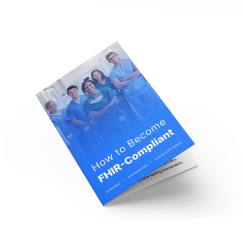Traditional approaches for diabetes management often rely on periodic clinic visits, limiting the ability to track patients' health in real time. However, with the advent of remote diabetes monitoring, healthcare providers can now remotely gather vital health data, such as blood glucose levels, medication adherence, and lifestyle patterns.
This technology empowers patients to actively participate in their own care while enabling healthcare professionals to deliver targeted interventions based on real-time insights. By embracing remote diabetes monitoring, healthcare systems are moving towards a more patient-centered approach that enhances the overall quality of diabetes management (source ).
In this article we will delve into the significance of remote patient monitoring in diabetes and consider the challenges associated with traditional healthcare approaches.
Build compliant and secure RPM apps with healthcare software engineering experts
Implementing RPM for diabetes patients
Remote patient monitoring has emerged as a valuable tool in managing diabetes. However, the implementation of RPM for the management of diabetes comes with its own set of challenges.
One of the main challenges lies in ensuring seamless connectivity between patients and healthcare providers. Establishing a secure and reliable platform that enables the transfer of data, such as blood glucose readings, medication adherence, and lifestyle information, is essential. Data privacy and security issues must be addressed to protect sensitive patient information.
Despite these challenges, the benefits of diabetes management through remote patient monitoring are substantial. Research has shown that RPM can enhance patient engagement and self-management. It enables patients to participate actively in their diabetes care by giving them real-time data and personalized feedback. Furthermore, RPM allows healthcare providers to promptly identify trends and potential complications, leading to timely interventions and improved outcomes.
Several studies have demonstrated the positive impact of diabetes remote health monitoring. Research has shown that RPM interventions can improve glycemic control, reduce hospitalizations, and better adherence to treatment plans. Additionally, remote patient monitoring has been associated with increased patient satisfaction, as it offers convenience and reduces the need for frequent in-person visits.
Remote patient monitoring for the management of diabetes has the potential to revolutionize diabetes care. While implementation challenges exist, the benefits of RPM are significant, ranging from enhanced patient engagement to improved clinical outcomes. Ongoing research highlights the positive impact of diabetes management through remote patient monitoring, solidifying its role as a valuable tool in modern healthcare.
Want to become HIPAA-compliant?
Learn about best practices of FHIR implementation.

The benefits of building RPM systems for diabetes patients
RPM diabetes systems offer numerous advantages, benefiting both patients and businesses that aim to implement such solutions. Let's explore some key benefits below:
- Gather real-time data: RPM enables the collection of real-time data, allowing healthcare providers to monitor important metrics like blood glucose levels, medication adherence, and lifestyle patterns. This data provides valuable insights into patients' health status and helps make informed treatment decisions.
- Provide immediate intervention opportunities: With remote diabetes monitoring, healthcare providers can identify potential complications or deviations from the treatment plan in real time. This allows for prompt intervention, preventing adverse events and promoting better health outcomes.
- Minimize readmissions: Healthcare providers can detect early warning signs of deteriorating health by closely monitoring patients remotely and intervening promptly. This proactive approach reduces the likelihood of hospital readmissions, leading to improved patient well-being and cost savings for healthcare systems.
- Increase profitability: Implementing RPM systems can benefit healthcare businesses financially. Reducing hospital readmissions and emergency room visits can minimize healthcare costs. Additionally, remote monitoring can optimize resource allocation and streamline workflows, improving operational efficiency.
- Improve competitive advantage: Embracing remote diabetes monitoring can set businesses apart from their competitors. Offering advanced and patient-centered care solutions can attract more patients, strengthen customer loyalty, and enhance the reputation of healthcare organizations.
- Expand access to care: RPM systems facilitate remote care delivery, enabling patients to access healthcare services from the comfort of their homes. This is especially beneficial for individuals with limited mobility or those residing in remote areas, providing them with equal access to quality diabetes management.
- Address the shortage of care: Implementing remote diabetes monitoring can help address the shortage of healthcare professionals by extending their reach and impact. Providers can manage a larger patient population effectively while ensuring personalized care through remote monitoring technologies.
- Relieve provider burnout: Healthcare providers often face high workloads and burnout. RPM systems alleviate some of the burdens by automating data collection and alert systems. This enables providers to focus on critical interventions and personalized care, reducing stress and enhancing job satisfaction.
- Benefit the doctor-patient relationship: Remote diabetes monitoring fosters a stronger doctor-patient relationship. Patients feel supported and engaged in their own care as they receive regular feedback and personalized guidance from healthcare providers. This partnership enhances trust, communication, and overall patient satisfaction.
- Enhance patient empowerment and self-management: RPM systems empower patients with diabetes to actively participate in their own care. By providing access to real-time data, educational resources, and personalized feedback, remote diabetes monitoring encourages self-management behaviors. Patients gain a deeper understanding of their condition, leading to increased confidence, better adherence to treatment plans, and improved overall well-being.
Implementing RPM systems for diabetes patients brings substantial benefits, ranging from improved patient outcomes to business advantages such as cost savings, enhanced competitiveness, and expanded access to care.
By embracing remote diabetes monitoring, healthcare organizations can revolutionize diabetes management and deliver high-quality, patient-centered care.
Examples of diabetic remote-health monitoring systems
Here are several examples of companies that have implemented various solutions focusing on diabetes and telehealth technologies as a way to improve the management of this condition.
Clarity
CLARITY is a diabetes management software from Dexcom, a pioneer in continuous glucose monitoring (CGM) (source ).
The solution consists of the Dexcom G6 CGM system, which includes a wearable sensor and transmitter to send real-time glucose readings to a smart device every five minutes. The CLARITY software platform tracks and analyzes the patient's blood glucose data, providing visual insights and trends.
Dexcom is also collaborating with Verily to develop less-intrusive, implantable, Bluetooth-enabled implantable diabetes sensors for future RPM products (source ).
Glooko
Glooko offers a comprehensive remote monitoring platform that integrates data from various diabetes devices, such as glucose meters and insulin pumps. The system tracks patients' blood glucose levels, medication adherence, and lifestyle factors.
Healthcare providers can remotely access this data, enabling personalized interventions and proactive management (source ).
Livongo
Livongo provides a connected health solution for diabetes management. Their remote monitoring system collects real-time data, including glucose levels and activity metrics, and provides personalized insights and coaching to patients.
The system also offers 24/7 support from certified diabetes educators, empowering patients to make informed decisions about their care (source ).
UCHealth
UCHealth has implemented a diabetes remote monitoring program that helps patients effectively manage this dangerous disease.
The program utilizes remote monitoring devices to collect real-time data on blood glucose levels, insulin usage, and other relevant health metrics. Through telehealth consultations, healthcare providers can review the data, make informed treatment decisions, and provide timely patient support (source ).
These examples showcase how health-tech companies leverage remote monitoring diabetes technologies to transform diabetes care.
It is worth noting the great role of RPM companies in the implementation of these technologies. Thanks to the advent of new technological solutions, remote diabetes monitoring is now much more effective than ever.
Binariks, in turn, specializes in the integration and customization of remote-health monitoring systems. In particular, we have experience in both creating RPM solutions and integrating them with EHRs and scalable data storage solutions.
Our expertise enables you to combine IoT, data analytics, and wearable technologies in one solution. Besides, Binariks prioritizes data security and interoperability by implementing FHIR data standard and selecting HIPAA-compliant tech stacks.
Some statistics for 2023: Trends and the future perspectives
Diabetes is a global health challenge, with an estimated 463 million adults living with the condition worldwide in 2020. By 2045, this number is projected to reach a staggering 700 million. The economic impact of diabetes is significant, with the total cost reaching $327 billion in the United States in 2017, including direct medical costs and lost productivity (source ; source ).
Remote patient monitoring technology, which allows healthcare providers to remotely monitor vital health indicators, is revolutionizing diabetes management. In 2021, diabetes emerged as the dominant application segment in the Remote Patient Monitoring market, capturing a significant market share of 12.8% (source ). As technology continues to evolve, this trend in diabetes management is expected to continue.
For example, according to the Diabetes Care Survey, 47 percent of patients surveyed said they would test their glucose more consistently if they were aware that the results would be transmitted to their healthcare provider (source ). And this figure represents a 12 percent increase from the previous year's survey.
To sum it up, this aligns with the RPM gaining popularity among healthcare providers and patients due to its ability to drive patient adherence and engagement and potentially improve outcomes.
Final thoughts
In conclusion, the development of rpm and diabetes care management has transformed the way healthcare providers approach diabetes treatment. By embracing remote patient monitoring, healthcare organizations can deliver personalized care, enhance patient engagement, and improve health outcomes.
Binariks, with its expertise in technology integration and customization, is uniquely positioned to assist healthcare organizations in optimizing RPM systems for effective diabetes care management.
By partnering with Binariks, healthcare organizations can unlock the full potential of diabetes care remote patient monitoring. Check crucial health data, make informed treatment decisions, and empower patients to actively participate in their diabetes management.
FAQ
Share

